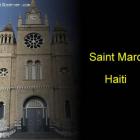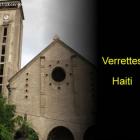ADVERTISEMENT
History
We have pictures of some of the best historical sites in Haiti, including The National palace, The Citadelle, San Souci palace, and many historical buildings that contributed to the history of Haiti
Eske Haiti Jam Gin lide Nan Nivo Nelson Mandela?
Eske nou panse si nou te ginyin yon lidè tankou Nelson Mandela nou pap kote nou ye la konyè-a? Mandela was a figure of enormous moral influence, a symbol of revolution, resistance and triumph. Also he was a man of great vision for his country of South Africa.
This man is responsible for moving his country from a period of apartheid and injustice to a more just society.
Yon sel moun yo rele Nelson "Rolihlahla" Mandela fè changeman sa nan peyi li
Eske nou panse nou gin moun an Ayiti Ki kapab Fè Yon Bagay Konsa?
Vertierre or Vertieres, Pivotal in Haiti Independence
Saint Domingue on island of Hispaniola was once the most lucrative part of French colony on the Caribbean island from 1659 to 1809. But a slave revolt in which the battle of Vertierre or Vertieres was pivotal ended the colonization. With support of British government ended the French rule in Saint Domingue and the French were forced to withdraw themselves from this European colony in 1803.
The decisive encounter between General Rochambeau of the French army and the separatist British supported leader General Jean-Jacques Dessalines is known as 'War of Vertières'. General Dessalines who was born as a slave led the struggle against the French. The British weakened the French by naval blockades and supplied weapons and ammunitions to General Dessalines. Sensing danger, Rochambeau shifted French headquarters from Port-au-Prince to Cap Français. Dessalines went on capturing places one after another like Jacmel, Cayes, Jérémie and Léogane. When the French Commander surrendered himself on October 3 at Port-au-Prince, stage for physical attack was set on Le Cap Français.
Haitian President Alexandre Petion, gens de couleur libres
Born a member of the gens de couleur libres, Alexandre Sabes Petion (1770 - 1818) began life between two worlds. It is a dichotomy he would continue, further marking his legacy as an instrumental force behind the struggle for independence of two lands, his own beloved Haiti, and the republic of Gran Colombia.
Alexandre Petion began his career, after an expensive education in France, by joining the fight to force the British out of Saint-Domingue between 1798 and 1799. He would subsequently fight on the side of the mulattos against Toussaint L'Ouverture and the blacks, and was exiled to France when the rebellion ended; he returned soon after with General Leclerc and his assemblage of warships and troops. In 1802, he joined the nationalist force and gave his support to Jean-Jacques Dessalines, the future proclaimer of the Haitian Independence and self-declared ruler for life of the newly formed country.
The "Ark of Return" a Masterpiece of Remembrance and Triumph
A United Nations international panel of five judges picked Haitian-American Rodney Leon's modernistic and abstract sculpture as the winning art piece that will be installed near the United Nations Plaza in Manhattan in fall of 2014. Titled "The Ark of Return", it is a stunning representation of a slave ship, which will be hewn in immaculate white marble.
Len, a gifted designer and architect, also has another sculpture piece on display in lower Manhattan, the African Burial Ground National Monument. Leon, during his project presentation, educated the judges on the symbolic intent of the ark. In essence, he said the piece invites the viewer to explore it interiorly and exteriorly, a place of meditative thought and reflection, as part of an educational and transformative experience. It is meant to be a conduit to remembering the past without the shackles of shame attached to it.
International Day for the Remembrance of the Slave Trade and its Abolition, Saint-Domingue
Hundreds of years of African slavery have been whittled down by most of the world as 'that thing most wished forgotten'. However, on Friday the 23rd of August, 2013, those who will never forget took the time to remember a past that still colors the present on the International Day for the Remembrance of the Slave Trade.
Imagining what months spent on board a rocking ship along the middle passage was like is thrown into sharp context when the diagram of the slave ship the Brookes is shown, and one is hard-pressed to remain unmoved when remembering the 142 thrown overboard to make way for water during the Zong massacre. However, as many focus on the tales of the horrors, the indignities and the atrocities that prevailed then, what should not be forgotten is the way in which the slave trade ended.
Francois Makandal or "Macandal" a Maroon Leader
In 1750s, free mulattoes and blacks starts to amass power and wealth. Many secure plantations, particularly coffee plantations in the South and the West. In 1759, there is Makandal Conspiracy. Francois Macandal, a maroon leader, conspires a plot that is to spread to all corners of the colony of poisoning the whites in the North. It all begins in the North, with the vast network of Makandal collaborators, particularly trusted domestic workers, starting to poison the households of their masters, including those slaves who cannot be trusted. There is a frantic search by the whites on the nature and cause of the illnesses and death. A female slave is interrogated, and she betrays the rebel leader. A massive manhunt is launched by the planters.
The 222nd anniversary of the Ceremony Bois Caiman
The Haitian community is preparing for the 222nd anniversary of the Bois Caiman Ceremony. The ceremony is celebrated to mark a remarkable event which gave birth to the first ever black republic in the world. Bois Caiman Ceremony first celebrated on the 14th day of August 1791 remains a symbolic event in the history of humanity.
In reminder to the Haitian people Lesly Condé expressed his expectation for good participation from the Haitian Community during this important event. Lesly is the Consul General of the Republic of Haiti in Chicago.
The French Revolution in Saint-Domingue (Haiti) from 1788 to 1790
The French Revolution begins in June 1788 with the Third Estate assembling in the tennis court at Versailles to draft a new constitution and declare itself as "the nation, the true representative of the people," being sworn as "a body, never to disperse." In fall 1788, Saint Domingue's Provincial Assembly receives a petition requesting "political rights for free persons of color." a similar petition is submitted in November by a white colonist.
In 1789, Martinique slaves revolt partly because of the influence of the French Revolution. The instability of Saint Domingue also increases. On 17th June 1789, the Third Estate declares itself the National Assembly in France. On 14th July 1789, the fall of the Bastille triggers commencement of the French Revolution. The social and political structures of France descent into chaos as violence break out. On 26th August 1789, the National Assembly adopts the declaration of the Rights of Man and Citizens.
The Ruins of Fort Picolet near Cap-Haitian
In 1736, Mr. Larnage began the construction on Fort Picolet as a means of maintaining France's stronghold on the Haitian colony. With the Spanish realm so close at hand in neighboring Dominican Republic, the fort to the west of Cap-Haitien was an important means of keeping the French realm intact against the threat of invaders. When construction finished in 1741, the fort was a grey profusion, sticking out from the side of a rocky promontory, with walls seemingly un-scalable for their height and the danger they presented hanging over the cliff's edge and being out into sea. Atop their walls was a phalanx of cannons, trained and ready for any impending attack, and the steep steps, descending dangerously in most points were a further deterrent to those who would seek invasion.
How Haiti Earthquake of 1770, anthrax outbreak and the Haitian revolution are related
In 1770, Haiti's capital Port-au-Prince was struck by an earthquake. The political and social institutions of those times were completely shocked and blundered by the earthquake. Taking advantage of the destruction, majority of the slaves managed to escape, leading to further chaos. The stability of the country was lost and it went on to prove that Haiti then depended on its slaves for its stability. Even more disturbing was the fact that immediately after the earthquake, a mysterious plague claimed the lives of 15,000 people in Haiti.
The escaped slaves were responsible for harvesting and cooking and in their absence, the country was starving. Hiding in the countryside, the slaves even managed to cut off the supply of wild food, worsening the situation even more for the city-dwellers. As a result people purchased meat from Spanish merchants. These merchants failed to sell these meat in Spain. Soon there was an outbreak and people started falling sick with blackened lesions that were painful and eventually led to death. Back then, people could not figure out what caused this. Some thought it to be smallpox while epidemiologist Noah Webster called it Black Death.
Our objective is to share with you news and information about Haiti and the people of Haiti. Traditions, habits and the way we were or grew are alive in this site. We highly recommend that you Subscribe to our Newsletter and also share with us some of the things that are memorable and made us unique people.

 Saint Marc, Haiti
Saint Marc, Haiti  Haiti tech Summit
Haiti tech Summit  The Town of Savanette, Haiti
The Town of Savanette, Haiti  Verrettes, Haiti
Verrettes, Haiti  Battle of Vertieres
Battle of Vertieres